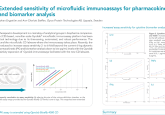Research identifies five biomarkers that could aid the diagnosis of sepsis

Researchers from the University of Illinois (IL, USA) and the Carle Foundation Hospital in Urbana (IL, USA), have identified five key biomarkers in the blood that could provide as much information about sepsis as hours of monitoring symptoms. The immune responses that triggers sepsis could however, be utilized to detect its presence in the initial stages.
Ruoqing Zhu, a professor at the University of Illinois commented: “Sepsis is a process that happens very rapidly. A patient could change from stable to near death in a matter of days or hours. Data show us that if a patient is treated within a few hours of showing symptoms, there is a high survival rate. But as time lengthens, survival rate drops dramatically. So early decision-making is very crucial in treating sepsis.”
Sepsis develops when an infection in the body causes an overreaction of the immune system. The resulting inflammation can quickly lead to organ failure and death. At present, health professionals monitor a patient’s vital signs over time to watch for key symptoms indicating the presence or development of sepsis.
“Sepsis is one of the most deadly and costly conditions for hospitals in the United States, striking roughly 20 percent of patients admitted to intensive care units and accounting for more than 5 percent of health care costs nationwide,” stated Rashid Bashir, a professor at the University of Illinois.
The Illinois group took a novel approach to measuring biomarkers in the blood, which identified an elevated immune response as a method of quickly identifying patients in the early to peak phases of sepsis. A new point-of-care device, which can measure biomarkers in a single drop of blood, was described by the group in a recent paper published in Nature Communications.. The latest study by the team examines the predictive power of five key sepsis biomarkers when compared with traditional methods.
“These biomarkers are the first things that get triggered in the progression of the disease, so it makes sense to look at them if you want to make a more accurate early diagnosis,” commented Ishan Taneja (University of Illinois), the first author of the study.
The researchers used vital sign data and blood samples to determine whether the biomarkers could be used in the identification of patients in the early to peak phases of sepsis. Machine learning models were utiized to determine which method had the greatest predictive power: traditional vital sign data, using biomarkers alone, or using a combination of the two.
The greatest predictive power was provided by combining biomarker data with electronic medical record data. However, it was also discovered that biomarkers alone were better predictors of the presence of sepsis than electronic medical records alone. Indeed, the levels of one biomarker measured from a single blood draw produced the same results as 16 hours of additional time monitoring vital signs – time which could be critical for the administration of treatment.
“These results support that the biomarkers reflect your health status quicker than outward signs. Vital signs and other symptoms are observed from outside the patient, but biomarkers show what’s going on inside the body. They change immediately once certain processes are triggered,” stated Zhu.
The Illinois researchers and Carle physicians plan to continue working together to further establish the potential of these biomarkers for diagnosing sepsis. They also intend to develop the point-of-care device to integrate all five of the biomarker readings. Finally, they hope to further track the development of sepsis to aid physicians in identifying the stage of the disease.
Sources: Taneja I, Reddy B, Damhorst G et al. Combining biomarkers with EMR data to identify patients in different phase of sepsis. Sci. Rep. doi:10.1038/s41598-017-09766-1 (2017); www.eurekalert.org/pub_releases/2017-09/uoia-sba090717.php






